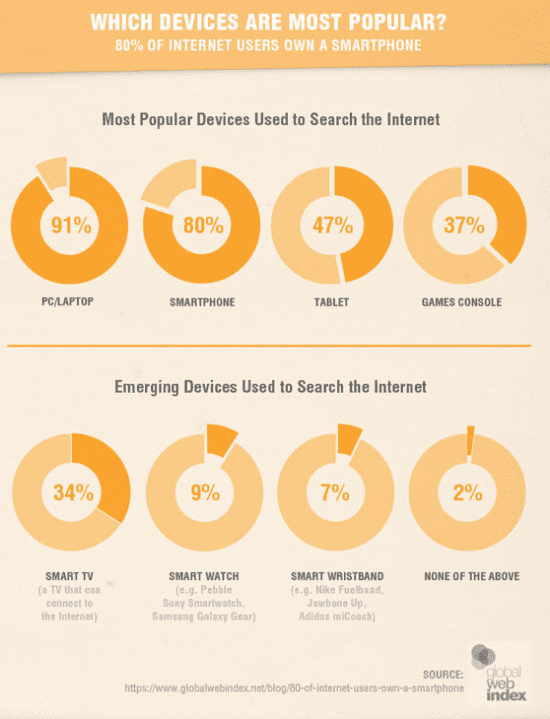Google’s mobile update has far-reaching implications for your website and business. Although the effects will be limited in the short term, in the longer term Google’s making a clear statement and more aggressively pushing businesses in a specific direction than ever before. Read this quick and easy blog post to gain an understanding of what’s happened, what’s about to happen, and how you can jump out in front of this mobile update to continue to gain as much business from search engines as possible.
The Google Mobile Update
Mobilgeddon – can we Internet marketers be any more dramatic? I was talking with a friend who works at a Newspaper doing digital sales and she was shocked I wasn’t more excited about the impending doom – “Q2 in 2015 is Mobilegeddon! Most of the geeks like you in my office are so excited. Like, it’s Y2K all over again. I’m surprised you don’t care more.” Wow, there’s a lot to unpack there. Subtle digs aside, we’re not that concerned.
Let’s take this step-by-step:
What’s Changing at Google (With Mobile)
For some time mobile and tablet use has been skyrocketing. In fact last year (2014) we saw the use of non-desktop devices (Tablets, Mobile Phones, peacocks, etc.) out number PC’s online. At this point mobile and desktop use are virtually deadlocked. If mobile devices haven’t this very second beaten out desktops, they surely will by end of year. However, of most interesting note, is search – take a look at the table below from SmartInsights.com:

Smartphone’s are QUICKLY approaching desktops in search. And we’ve reported on this before. If you’ll review my post on Local Search:
Nearly 90% of purchases for local goods and services are first researched online (overwhelmingly via search engines)! And more than 73% of business traffic is driven by search.
So search is important, and the trends are pointing that mobile search is going to go the way of mobile use -UP- as more people use their phones and tablets to search for solutions, content, etc. I’m sure you’re guilty of this. You’re on the road and looking for a place to eat. You whip out your iPhone and query google for a great restaurant. Our perhaps you’re in a store and quickly search for reviews of a product you’re holding along with the corresponding price online?
Mobile Use and Search is Exploding
Google’s seen these trends and has responded. For some time they’ve already been testing out various new presentations, tags, etc. to help make the experience of searching and selecting appropriate results better and easier for users on mobile devices. For example, Barry Schwartz reported back in February over on SearchEngineLand that he had spotted Google testing a new “SLOW” tag within mobile search results pages (SERPs). Although this latest update doesn’t yet fully include this new “slow” tag – many SEOs who read between the lines have known for many months that Google would implement some kind of system to weight mobile friendly-sites.
What IS The Google Mobile Update
Google is always looking to connect it’s users with the most relevant results possible – while also providing a great user experience. As the web has evolved, so has their role in helping to push technology forward using this as a guiding principal. Google has always continued to provide an amazing experience to searchers. Their results continue to be accurate, relevant, timely, and only seem to be getting better.
In continuing this trend – they’ve analyzed the device landscape and have decided to more greatly split up search.
Just as, in the past, Google has started to show you different results based on your:
- Location
- Search History
- Social Network
- And many other factors…
You’ll now be shown different results based on your device (which was already the case to some extent) – only it will be more dramatic. In addition to this (or as an extension of this) if you’re using a mobile or tablet device – you’ll see search results that feature in-app content (which has already been available for sometime, but which will be much more dramatic moving forward).
If you search using a tablet or mobile device, the sites you’ll see will be more tablet/mobile friendly. For the complete picture on the latest mobile update from Google, we turned directly to the Google Webmasters blog post on the matter. In a nutshell we’ve distilled everything into what you need to know:
If your website isn’t “mobile-friendly” Google MAY LOWER your rankings in search results via mobile devices.
Of important note though is this phrase:
The intent of the search query is still a very strong signal — so even if a page with high quality content is not mobile-friendly, it could still rank high if it has great content for the query.
This means that basically Google is more heavily weighting how well your site responds to mobile devices (speed, design, etc.) and weighting their rankings appropriately. However, reading between the lines, particularly in that last statement, content is still kind – and if your website provides the best actual content and answers, odds are they’ll continue to show your content. However, all things being equal it’ll be important to optimize your website Mobile.
How Do You Know if Your Website is “Mobile” Friendly?
Take a look at the graphics to the right:
- The first image shows a website on a phone or tablet – it’s text is small – it’s a conventional website probably created 1+ years ago. This website is NOT optimized for mobile devices as you must pinch and zoom in order to see the content and the links aren’t large enough to be easily click-able.
- The second image shows a website with larger text and easy-to-click buttons. This website is probably newer, and what we in the industry call “responsive.”
You can also check out the Mobile-Friendliness tool provided by Google that will give you a ‘yes’ or ‘no’ answer on a per-url basis on whether or not your website is mobile friendly.
Finally, one last way you can easily check to see if your website (or any website) is responsive, is to open it in a desktop browser. Once loaded, take your browser and resize it – making it much slimmer (see graphic below). A “responsive” site “responds” to the size of the browser – meaning it changes based on the container it’s being viewed. If the site you’re looking at changes like this – it’s responsive and mobile friendly.
All Atilus clients who built their site in the last 2-years have been responsive and are already mobile friendly.
Google Mobile Search – Short Term Impact
It’s been roughly a week since Google publicly declared their intention to modify mobile search results, showing more mobile-friendly sites higher up and demoting less mobile-friendly sites. So far, we’ve seen little change across the board. Our own site has seen a slight uptick in traffic most likely due to the change. Some websites that we manage or created sometime ago, that aren’t mobile friendly – seem to be unaffected at this point with virtually no change in search results (on both mobile and conventional desktop searches).
One important point to consider right away is that site speed, more than ever, is very important. After great content, the biggest impact you can have when considering all factors is increasing your website’s speed – which will have an impact on your search results across both mobile and desktop.
Google Mobile Search – Long Term Impact
More and more both Google’s products, and their agenda, have become an integral part of how they rank websites.
I find it interesting that they’re now basically, even modestly, promoting sites with a particular design in mind. At the end of the day this makes sense from a usability stand point, however I wonder what the longer-term implications of this are if this trend continues.
No longer are you evaluated solely on the merit of your content, but on the design of your site.
And I’d argue it IS design. If in the past they evaluated things like load times, conversion rates, time on site, etc. – now they’re evaluating design (at least it appears that way based on how they’re evaluating CSS and per the imagery above – which was ripped straight from Google Webmaster Tools’ blog). My only concern with this is that modern, responsive design trends have led to (sometimes) more easily view-able content across an array of devices, but I feel many responsive sites cater to the lowest common denominator and actually lead to poorer conversion rates and results for clients.
Finally, in addition to essentially evaluating sites on design we’re seeing the intersection of Google’s Search and Google’s phone OS. Apps are now a large part of the search results being provided. It’s a helpful way to get to content, but ultimately might lead to a dangerous techno monoculture where Google knows all, and pushes all – and because we as Digital Marketers know Google is the biggest game in town – we leap to satisfy their demands.
Similar Posts



